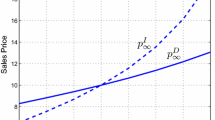Abstract
This paper investigates retailers’ competition and cooperation in a closed-loop green supply chain consisting of one common manufacturer and two competing retailers under governmental intervention and cap-and-trade policy. Considering a consistent pricing strategy of the manufacturer, this study develops one centralized policy and three manufacturer-led decentralized policies viz. Collusion, Cournot (Nash), and Stackelberg depending on different competitive behaviors of the retailers. Optimal decisions are compared analytically through a special case where the retailers face the same basic market, and numerically where they face both the same basic market and different basic markets. A transfer payment mechanism is developed so that all the channel members achieve Pareto improvement. Numerical results indicate that (1) among the three decentralized scenarios, Nash behavior is profitable to the manufacturer, customers, and the whole supply chain, but Collusion behavior is profitable to the retailers only when the difference of their basic markets is small, (2) when the retailers face the same basic market and play Stackelberg game, it is beneficial for the retailers to be follower rather than leader, and (3) occurrence of both the government subsidy and cap-and-trade policy is profitable to all the channel members.





Similar content being viewed by others
Notes
Emission Trading Scheme: A Brief Overview and Indian Perspective. On February 7, 2015, By Hariharan.
References
Aust G, Buscher U (2012) Vertical cooperative advertising and pricing decisions in a manufacturer-retailer supply chain: a game-theoretic approach. Eur J Oper Res 223(2):473–482
Cao K, Xu X, Wu Q, Zhang Q (2017) Optimal production and carbon emission reduction level under cap-and-trade and low carbon subsidy policies. J Clean Prod 167:505–513
Choi TM, Li Y, Xu L (2013) Channel leadership, performance and coordination in closed loop supply chains. Int J Prod Econ 146(1):371–380
Dobos I (2005) The effects of emission trading on production and inventories in the Arrowe–Karlin model. Int J Prod Econ 93:301–308
Du S, Zhu L, Liang L, Ma F (2013) Emission-dependent supply chain and environment-policy-making in the ‘cap-and-trade’ system. Energy Policy 57:61–67
Ghosh D, Shah J (2012) A comparative analysis of greening policies across supply chain structures. Int J Prod Econ 135(2):568–583
Giri BC, Chakraborty A, Maiti T (2017) Pricing and return product collection decisions in a closed-loop supply chain with dual-channel in both forward and reverse logistics. J Manuf Syst 42:104–123
Giri BC, Mondal C, Maiti T (2018) Analysing a closed-loop supply chain with selling price, warranty period and green sensitive consumer demand under revenue sharing contract. J Clean Prod 190:822–837
Guo D, He Y, Wu Y, Xu Q (2016) Analysis of supply chain under different subsidy policies of the government. Sustainability 8:1290. https://doi.org/10.3390/su8121290
He P, He Y, Xu H (2019) Channel structure and pricing in a dual-channel closed-loop supply chain with government subsidy. Int J Prod Econ 213:108–123
Hanssens DM, Parsons LJ, Schultz RL (2003) Market response models: econometric and time series analysis, vol 12. Springer, Berlin
Huang H, Ke H, Wang L (2016) Equilibrium analysis of pricing competition and cooperation in supply chain with one common manufacturer and duopoly retailers. Int J Prod Econ 178:12–21
Jafari H, Hejazi SR, Rasti-Barzoki M (2016) Pricing decisions in dual-channel supply chain including monopolistic manufacturer and duopolistic retailers: a game-theoretic approach. J Ind Compet Trade 16:323–343
Jamali MB, Rasti-Barzoki M (2018) A game theoretic approach for green and non-green product pricing in chain-to-chain competitive sustainable and regular dual-channel supply chains. J Clean Prod 170:1029–1043
Krishnan V, Lacourbe P (2011) Designing product lines with higher aggregate environmental quality. Available at SSRN 1744301
Kurata H, Yao DQ, Liu JJ (2007) Pricing policies under direct vs indirect channel competition and national vs. store brand competition. Eur J Oper Res 180:262–281
Li B, Zhu M, Jiang Y, Li Z (2016) Pricing policies of a competitive dual-channel green supply chain. J Clean Prod 112:2029–2042
Li B, Chen W, Xu C, Hou P (2018) Impacts of government subsidies for environmental-friendly products in a dual-channel supply chain. J Clean Prod 171:1558–1576
Liu S, Xu Z (2014) Stackelberg game models between two competitive retailers in fuzzy decision environment. Fuzzy Optim Decis Mak 13:33–48
Luo R, Fan T (2015) Influence of government subsidies on carbon reduction technology investment decisions in the supply chain. IEEE. https://doi.org/10.1109/ICSSSM.2015.7170143
Madani SR, Rasti-Barzoki M (2017) Sustainable supply chain management with pricing, greening and governmental tariffs determining strategies: a game theoretic approach. Comput Ind Eng 105:287–298
Maiti T, Giri BC (2017) Two-way product recovery in a closed-loop supply chain with variable markup under price and quality dependent demand. Int J Prod Econ 183:259–272
Mitra S, Webster S (2008) Competition in remanufacturing and the effects of government subsidies. Int J Prod Econ 111:287–298
Modak NM, Panda S, Sana SS (2016) Two-echelon supply chain coordination among manufacturer and duopolies retailers with recycling facility. Int J Adv Manuf Technol 87:1531–1546
Mondal C, Giri BC (2020) Pricing and used product collection strategies in a two-period closed-loop supply chain under greening level and effort dependent demand. J Clean Prod 265:121335. https://doi.org/10.1016/j.jclepro.2020.121335
Mondal C, Giri BC, Maiti T (2020) Pricing and greening strategies for a dual-channel closed-loop green supply chain. Flex Serv Manuf J 32(3):724-761
Pang Q, Li M, Yang T, Shen Y (2018) Supply chain coordination with carbon trading price and consumers’ environmental awareness dependent demand. Hindawi Math Prob Eng Article ID 8749251. https://doi.org/10.1155/2018/8749251
Pujari D (2006) Eco-innovation and new product development: understanding the influences on market performance. Technovation 26(1):76–85
Qi Q, Wang J, Bai Q (2017) Pricing decision of a two-echelon supply chain with one supplier and two retailers under a carbon cap regulation. J Clean Prod 151:286–302
Savaskan RC, Bhattacharya S, Van Wassenhove LN (2004) Closed-loop supply chain models with product remanufacturing. Manag Sci 50(2):239–252
Seyed Esfahani MM, Biazaran M, Gharakhani M (2011) A game theoretic approach to coordinate pricing and vertical co-op advertising in manufacturer-retailer supply chains. Eur J Oper Res 211(2):263–273
Song JP, Leng MM (2012) Analysis of the single-period problem under carbon emission policies. Int Oper Res Manag Sci 176(2):297–312
Wang SD, Zhou YW, Min J, Zhong YG (2011) Coordination of cooperative advertising models in a one-manufacturer two-retailer supply chain system. Comput Ind Eng 61:1053–1071
Wu CH, Chen CW, Hsieh CC (2012) Competitive pricing decisions in a two-echelon supply chain with horizontal and vertical competition. Int J Prod Econ 135:265–274
Xiao T, Qi X (2008) Price competition, cost and demand disruptions and coordination of a supply chain with one manufacturer and two competing retailers. Omega 36:741–753
Xu J, Chen Y, Bai Q (2016) A two-echelon sustainable supply chain coordination under cap-and-trade regulation. J Clean Prod 135:42–56
Yang D, Xiao T (2017) Pricing and green level decisions of a green supply chain with governmental interventions under fuzzy uncertainties. J Clean Prod 149:1174–1187
Yang SL, Zhou YW (2006) Two-echelon supply chain models: considering duopolistic retailers’ different competitive behaviors. Int J Prod Econ 103:104–116
Yi P, Huang M, Guo L, Shi T (2016) Dual recycling channel decision in retailer oriented closed-loop supply chain for construction machinery remanufacturing. J Clean Prod 137:1393–1405
Zhang X (2014) Reference-dependent electric vehicle production strategy considering subsidies and consumer trade-offs. Energy Policy 67:422–430
Zhang CT, Wang HX, Ren ML (2014) Research on pricing and coordination strategy of green supply chain under hybrid production mode. Comput Ind Eng 72:24–31
Zhao J, Tang W, Wei J (2012) Pricing decision for substitutable products with retail competition in a fuzzy environment. Int J Prod Econ 135:144–153
Zhu Q, Dou Y (2011) A game model for GSC management based on government subsidies. J Manag Sci China 14(6):86–95
Zhu Q, Sarkis J, Geng Y (2005) Green supply chain management in China: pressures, practices and performance. Int J Oper Prod Manag 25(5):449–468
Acknowledgements
The authors are sincerely thankful to the Editor, the Associate Editor and anonymous reviewers for their helpful comments and suggestions on the earlier version of the manuscript. The funding was provided by University Grants Commission (F.No. 16-9(June 2017)/2018(NET/CSIR)) and Council of Scientific and Industrial Research (Grant Number 25(0282)/18/EMR-II).
Author information
Authors and Affiliations
Corresponding author
Additional information
Publisher's Note
Springer Nature remains neutral with regard to jurisdictional claims in published maps and institutional affiliations.
Appendix
Appendix
1.1 Proof of Proposition 1
The profit function for the manufacturer is given by
The profit function for the retailer i is given by
So, the profit function of the centralized policy is given by
Now,
The corresponding Hessian matrix is given by
Now, the leading principle minors are \(M_1 = - 2 \alpha < 0\), \(M_2 = 4 (\alpha ^2 - \beta ^2) > 0\) and \(|H| = 4 (\alpha + \beta ) [\Psi _3^2 - 2 \lambda (\alpha - \beta )]< 0\) if \(\lambda > \frac{\Psi _3^2}{2 (\alpha - \beta )}\). Thus‚ the Hessian matrix is negative definite if
\(\lambda > \max \{2 \gamma \Psi _1, \frac{\Psi _3^2}{2 (\alpha - \beta )}\}\). Using the first order conditions for optimality i.e. \(\frac{\partial \Pi ^{J}}{\partial p_1}=0, \frac{\partial \Pi ^{J}}{\partial p_2}=0\) and \(\frac{\partial \Pi ^{J}}{\partial \theta }=0\), the optimal values of the decision variables can be obtained as given in Proposition 1.
1.2 Proof of Proposition 2
Solving the equations \(\frac{\partial \Pi _{r}}{\partial p_1}=0\) and \(\frac{\partial \Pi _{r}}{\partial p_2}=0\) simultaneously, we get the optimal solution as
Substituting these values in the manufacturer’s profit function (1), we get the profit function of the manufacturer as follows:
Now,
The corresponding Hessian matrix of the manufacturer’s profit function is given by
Now, \(\frac{\partial ^2\Pi _m^{C}}{\partial \theta ^2}\) will be negative if \(\lambda > \gamma \Psi _1\) and \(|H| = 4 \lambda (\alpha - \beta ) - \Psi _3^2 > 0\) if \(\lambda > \frac{\Psi _3^2}{4 (\alpha - \beta )}\).
Therefore, the Hessian matrix corresponding to the manufacturer’s profit function will be jointly concave w.r.t w and \(\theta\) if \(\lambda > \max \{\gamma \Psi _1, \frac{\Psi _3^2}{4 (\alpha - \beta )}\}\).
Using the first order conditions for optimality i.e. \(\frac{\partial \Pi _m^{C}}{\partial w}=0\) and \(\frac{\partial \Pi _m^{C}}{\partial \theta }=0\), the optimal decisions of the manufacturer can be obtained and putting these decisions in retailers’ profit functions the optimal decisions of the retailers can also be obtained, which are given in Proposition 2.
1.3 Proof of Proposition 6
1.4 Proof of Proposition 7
Rights and permissions
About this article
Cite this article
Mondal, C., Giri, B.C. Retailers’ competition and cooperation in a closed-loop green supply chain under governmental intervention and cap-and-trade policy. Oper Res Int J 22, 859–894 (2022). https://doi.org/10.1007/s12351-020-00596-0
Received:
Revised:
Accepted:
Published:
Issue Date:
DOI: https://doi.org/10.1007/s12351-020-00596-0




